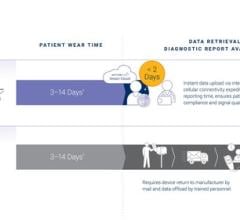
NorthEast Monitoring Inc. released LX Sleep, a software product that reportedly detects OSA from data collected during a simplified, overnight, at-home, patient hookup to its OxyHolter product.
In conjunction with NorthEast’s OxyHolter, LX Sleep provides a single-unit, multiparameter, unattended, home-based sleep study diagnostic tool designed to give patients an alternative to spending the night in an attended sleep lab. It is engineered to offer sleep labs the chance to fill their beds with patients known to have OSA who require CPAP with titration to achieve high quality sleep. ENT/Otolaryngologists can reportedly use the tool to eliminate sleep apnea patients from the patient pool considering surgery to reduce chronic snoring.
Initially the LX Sleep will be provided to end-users as a standalone module that runs on the same Holter database structure as is used with all of NorthEast’s Holter products (DR200/HE, DR180 ). When used with the DR180 OxyHolter, the LX Sleep module utilizes the additional SpO2 data to refine the diagnostic accuracy LX Sleep.
When the integration of LX Sleep with LX Analysis is complete, it will be an option licensed within NorthEast’s LX Analysis, for Holter ECG, software. NorthEast, the original creator of “Holter for Windows,” continues to refine that product in Holter LX Analysis.
The integrated LX Sleep software utilizes data from NorthEast’s OxyHolter product (ECG and SpO2) to provide direct as well as derived, multi-parameter, unattended, overnight sleep studies that aid diagnosis of sleep disorders, (i.e., OSA or obstructive sleep apnea), respiratory problems (OAD) and cardiology issues.
LX Sleep uses the direct ECG and SpO2 data plus other derived parameters to compute the AHI (Apnea Hypoxia Index). The algorithm is based on pattern recognition of SDB (sleep disturbed breathing) patterns in the ECG and impedence measurements to determine respiratory effort, SpO2 to determine efficiency or saturation, beat/pulse information and a movement channel are used to reduce artifact. The data is organized into epochs and filtered by classifiers based on patient types (adult or pediatric) to produce the proper AHI data.
Holter LX Analysis with its detailed ECG analysis and SpO2 trend information may be used for diagnostic purposes, but the specific AHI and report produced by LX Sleep may not. NorthEast will apply later this year for the 510(k) based on the integration of these products, including the enhancement to LX Sleep of using the SpO2 data.


 March 31, 2025
March 31, 2025 





